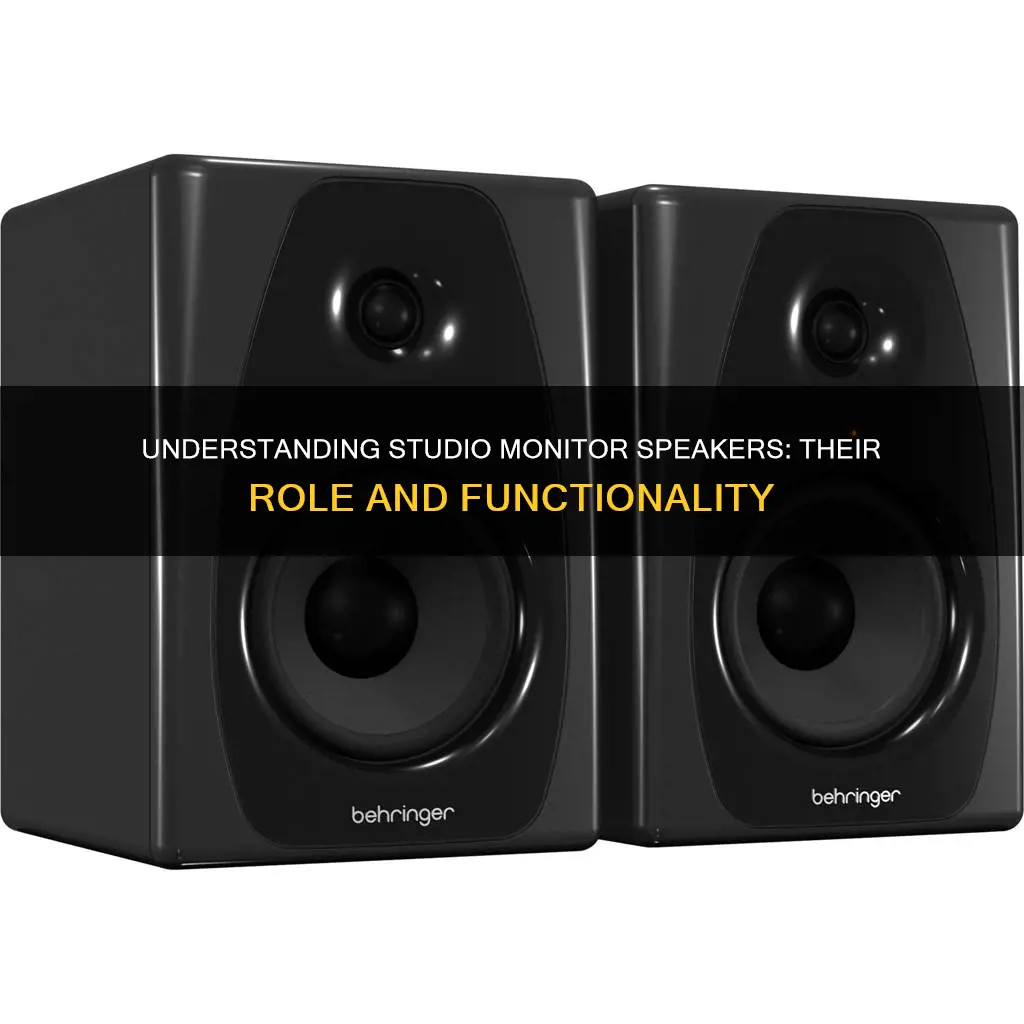
Studio monitor speakers, also known as studio speakers or reference loudspeakers, are loudspeakers designed for use in recording studios, radio stations, and other professional audio production environments. They are used for critical listening during the recording, mixing, and mastering process, and are essential for creating a great mix. Studio monitors are designed to have a flat frequency response, meaning all frequencies are played at the same volume level, resulting in an accurate and unbiased representation of the original audio signal. This is in contrast to regular Hi-Fi speakers, which are often coloured or biased to emphasise certain frequencies, such as adding more bass or treble, to create a more immersive listening experience. Studio monitors are also built to be more robust than home speakers to handle high volumes and sudden sound bursts. They are typically placed on stands or a mixing console, with the listener seated a few feet away, to create a neutral listening environment.
Studio Monitor Speakers Characteristics and Values
| Characteristics | Values |
|---|---|
| Purpose | Critical listening during recording, mixing and mastering |
| Use | Professional audio production applications, such as recording studios, filmmaking, television studios, radio studios, and project or <co: 0,2,3,4>home studios |
| Design | To produce a flat frequency response to accurately reproduce the tonal qualities of the source audio without distortion |
| Sound | Flat, precise, and uncoloured |
| Amplification | Active (with built-in amplifiers) or passive (requiring external amplifiers) |
| Speaker Design | 2-way (with a woofer for low frequencies and a tweeter for high frequencies) or 3-way (with an additional speaker for mid-range frequencies) |
| Speaker Placement | Near-field (placed a few feet away from the listener), mid-field (placed further from the listener in medium to large studios), or far-field (placed far away from the listener) |
| Speaker Projection | Designed for short distances and smaller areas to maintain true frequencies |
| Amplifier Configurations | Single-amp, bi-amp, or tri-amp |
| Wattage | Dependent on room size; 50-75 watts for small to medium rooms, 100 watts or more for large commercial studios |
| Cost | $200-$400 for beginners, $400-$1,000 for intermediate users, upwards of $1,000 for professionals |
What You'll Learn

Studio monitors are used for critical listening during recording, mixing and mastering
Studio monitors are designed to have a flat frequency response, meaning all frequencies are played at the same volume level. This is important for accurately balancing the levels of different frequencies in the audio, which is crucial when mixing. Studio monitors aim to give a true representation of the sound, ensuring accurate mixing and mastering.
Studio monitors are placed on stands or a mixing console, with the listener usually seated a few feet away. This setup allows the engineer to hear the audio in a relatively neutral listening environment. The placement and listening position are important factors in achieving accurate sound reproduction.
Studio monitors are typically used in near-field setups, where the speakers are placed close to the listener, minimising the effects of room acoustics. Near-field monitoring provides a clear, immediate sound, preventing the listener from hearing natural reverberations and providing a precise impression of the mix.
Studio monitors are also available in mid-field and far-field designs, which are larger monitors suited for bigger studio environments. These monitors extend the width of the sweet spot, allowing accurate stereo imaging for multiple listeners. Mid-field and far-field monitors are commonly used in film scoring environments, where simulation of larger areas like theatres is important.
Studio monitors are an essential tool for critical listening and play a crucial role in the recording, mixing and mastering process. They provide accurate sound reproduction, enabling engineers to make informed decisions and create well-balanced mixes that will translate well across different playback systems.
Setting Up Your Alienware Curved Monitor: A Step-by-Step Guide
You may want to see also

Studio monitors are designed to have a flat frequency response
Studio monitors are loudspeakers designed for professional audio production applications. They are used for critical listening during the recording, mixing, and mastering process. Studio monitors are designed to have a flat frequency response, meaning all frequencies are played at the same volume level. This is important for accurately balancing the levels of different frequencies in the audio, especially when mixing.
A flat frequency response also ensures that the tonal qualities of the source audio are reproduced accurately, without any emphasis or de-emphasis of particular frequencies. This is often referred to as an "uncolored" or "transparent" sound. Studio monitors aim to provide an accurate representation of the audio signal, in contrast to home stereo speakers, which are designed to create a pleasant and immersive listening experience.
The flat frequency response of studio monitors allows engineers to identify and fix any sonic imperfections in the recording. This is achieved by having multiple power amplifiers in one unit, with individual amplifiers for the woofer (bass), midrange, and tweeter (treble) cones. This results in a more precise sound, as each component has its own dedicated power amplifier.
The design of studio monitors prioritises accuracy and precision, ensuring that the audio signal is reproduced as faithfully as possible. This makes them essential tools for audio professionals in various fields, including recording studios, filmmaking, television studios, and radio studios.
Mounting an ASUS Monitor: A Creative Solution for Hole-less Designs
You may want to see also

Studio monitors are made to be physically robust
Studio monitors are often compared to home hi-fi loudspeakers, which typically only need to reproduce compressed commercial recordings. In contrast, studio monitors must handle high volumes and sudden sound bursts when playing back unmastered mixes. They are designed to be robust enough to handle these demands without compromising sound quality.
Studio monitors are an essential tool for audio professionals, enabling them to create accurate and immersive listening experiences. Their physical robustness ensures that they can withstand the rigours of the studio environment while delivering precise and transparent sound.
The physical robustness of studio monitors is a key factor in their ability to provide accurate audio reproduction, making them a crucial component in any recording, filmmaking, or broadcasting setup.
Finding Your AOC Monitor Model: A Step-by-Step Guide
You may want to see also

Studio monitors are placed on stands or a mixing console
Studio monitors are a crucial component of any recording studio, whether it's a spare room at home or a professional setup. Their placement is essential to achieving consistent results in your mixes. Here are some tips for placing studio monitors on stands or a mixing console:
Equilateral Triangle Setup
Position the studio monitors and your listening position (usually the mixing console) to form an equilateral triangle. This means the left and right speakers should be equidistant from each other and the listener, creating an equal-sided triangle. This setup helps create an accurate stereo image and a balanced soundstage, ensuring you can clearly hear both left and right channels. It also establishes an optimal "sweet spot" for monitoring, minimising phase issues and discrepancies in frequency response.
Ear Level Height
Place the studio monitors at ear level or slightly above. This ensures that the sound is directed accurately towards your ears, reducing unwanted reflections from surfaces. If your mixing console is too high or too low, consider using height-adjustable monitor stands to achieve the desired height. Speaker stands provide a stable and adjustable platform to position your monitors precisely at ear level.
Avoid Walls and Corners
Try to keep the studio monitors away from walls and corners. Placing monitors directly against walls or in corners can lead to a buildup of low-frequency energy and cause uneven frequency distribution, impacting the accuracy of your audio representation. It can also create imbalanced stereo imaging and increase the likelihood of sound reflections and phase cancellation issues. If your space is limited, aim to keep the monitors between 5 and 60 cm from walls to avoid the worst opposite waves and sound cancellation.
Avoid Reflections from Hard Surfaces
Acoustically hard surfaces, such as windows, drywall, mirrors, and non-absorbent materials, can reflect sound and alter the audio reaching your ears. Use a flat mirror to detect these reflections by positioning it on a nearby wall or desktop. If you can see the reflection of the speaker, apply absorption to that reflective surface.
Adjustments and Fine-Tuning
Listen to familiar music that you know sounds great on various systems and adjust your monitors until they sound accurate. If there is too much bass, move the speakers away from walls and corners to reduce the low end. Utilise any adjustments on the speakers, such as high-frequency and low-frequency boosts or cuts, to fine-tune the sound to your preferences and the specifics of your studio.
Best Monitor Arms: A Buyer's Guide
You may want to see also

Studio monitors are either active or passive
Studio monitors are loudspeakers used for audio and music production. They are used for critical listening during recording, mixing, and mastering. Studio monitors are either active or passive.
Active studio monitors have built-in power amplifiers, while passive studio monitors receive power from a dedicated standalone amplifier. Active studio monitors are usually bi-amplified, meaning the input sound signal is divided into two parts by an active crossover for low and high-frequency components. Both parts are then amplified using separate low- and high-frequency amplifiers. The low-frequency part is then routed to a woofer, and the high-frequency part to a tweeter or horn. This bi-amplification allows for a cleaner overall sound reproduction, as signals are easier to process before power amplification.
Passive studio monitors, on the other hand, offer more flexibility and upgradeability. The speakers and amplifier can be upgraded separately, allowing for a more gradual and cost-effective progression to higher-quality gear. Passive monitors are also generally lighter and easier to mount, as they do not have the extra components of active monitors.
The choice between active and passive studio monitors depends on the user's specific needs and preferences. Active monitors offer convenience and optimised sound, while passive monitors provide flexibility, upgradeability, and potentially better sound quality if the user is able to optimise their setup.
Ankle Monitor Removal: Stealthy Steps to Freedom
You may want to see also
Frequently asked questions
Studio monitor speakers, also known as studio speakers or reference loudspeakers, are loudspeakers specifically designed for use in professional audio production environments such as recording studios, filmmaking, television studios, radio studios, and home studios. They are used for critical listening during the recording, mixing, and mastering processes, providing an accurate and uncoloured representation of the audio signal.
Studio monitor speakers differ from regular speakers, such as home hi-fi speakers, in their design and purpose. Studio monitors are built to produce a flat frequency response, meaning all frequencies are played at the same volume level. This results in an accurate and neutral sound, which is crucial for mixing and mastering audio. Regular speakers, on the other hand, are often "coloured" or "biased" to emphasise certain frequencies, such as boosting bass and treble, to create a more immersive and enjoyable listening experience.
Studio monitor speakers offer several benefits. They provide an accurate representation of the audio signal, allowing audio professionals to make informed decisions during the mixing and mastering process. They are designed for critical listening, helping to identify and fix any sonic imperfections in the recording. Studio monitors are also robustly built to handle high volumes and sudden sound bursts that may occur during playback of unmastered mixes. Additionally, they are ideal for near-field monitoring, providing a clear and immediate sound by reducing the impact of room acoustics.







